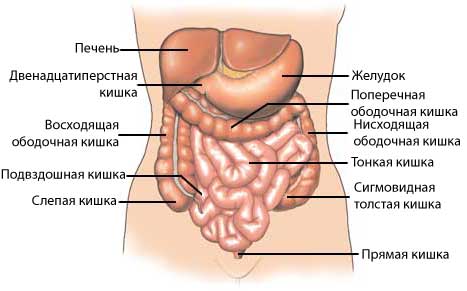Enterostomy
Description enterostomy
Enterostomy – surgery on the abdominal wall and intestines. In the intestine performed hole, to bring its content to the outside or put it in tube enteral nutrition. There are many different types enterostomy. One example is the jejunostomy, during which the opening is performed in the jejunum, part of the small intestine.

Reasons for enterostomy
The operation is performed, when you need a new exit for intestinal contents or feces. It may be necessary, if feces can not pass through the intestine to the anus.
Enterostomy may also be necessary, When food cannot normally get in your mouth or stomach. In this case it will be placed the feeding tube directly into the gut.
Possible complications enterostomy
Complications are rare, but no procedure does not guarantee the absence of risk. If you plan to enterostomy, you need to know about possible complications, which may include:
- Bleeding;
- Blood clots;
- Infection;
- Irritation of the skin around the stoma and the leakage of fluid from the intestine;
- Diarrhea;
- Ileus;
- Hernia at the site of abdominal incisions;
- Blockage or leakage of the input tubes, which requires replacement;
- Adverse reaction to anesthesia.
Some factors, that may increase the risk of complications:
- Smoking;
- Bleeding or clotting disorders;
- Active infection;
- Lung disease or heart disease.
We need to discuss these risks with your doctor before the procedure.
How is enterostomy?
Preparation for the procedure
- Consult your doctor about the drugs taken. A week before surgery you may be asked to stop taking some medicines:
- Anti-inflammatory drugs (eg, aspirin);
- Blood thinners, such as warfarin;
- Clopidogrel (Plaviks);
- Your intestines will be cleaned with a special solution;
- Your doctor will tell you about the physical and emotional difficulties, will have to face after the operation.
Anesthesia
At step will be used general anesthesia. It will block pain and will support you in the dream state.
Procedure enterostomy
There are different ways of carrying out this operation. According to one technique, inside the abdominal cavity is created intestinal sac for collecting fecal waste. This bag will include a stoma (opening) Abdominal wall. The stoma allows access to the bag to clean it (through a tube). When other vehicles intestine will be directly attached to the abdominal wall (colostomy), so that for fecal waste collection may be attached outside package.
If the operation is performed, to place the tube for enteral nutrition, in the abdominal wall incision is performed. Then, a small hole is made in the small intestine. Through this opening the tube inserted, which is fixed by means of sutures. The tube is then injected through the abdominal wall and also pinned seams.
These procedures can be conducted by the following methods:
- Through an open abdominal incision;
- With the laparoscopic procedure – a few small incisions.
How long will enterostomy?
- 30-45 minutes, to insert a tube;
- 2-4 o'clock, if the areas should be removed intestine;
Enterostomy – Will it hurt?
After the procedure may feel increased pain at the surgical site. Ask the doctor, what medicines you need to take, to reduce pain.
The average hospital stay
This procedure is performed in a hospital. Usually the duration of stay of 2-4 day. The doctor can extend the period of stay, If there are complications.
Care after enterostomy
Care in a hospital
- You may need antibiotics. You may also need to take medications for nausea and pain;
- If carried enterostomy, to assist the exit of faeces from the intestine, the outside of the body is secured bag of feces, in which the waste will be collected. You will receive instructions about diet. During the first few days after surgery, you may be limited in food;
- Staff will monitor the consumption of the liquid and its flow rate (because of the risk of dehydration);
- You will wear boots or special socks to help prevent blood clots;
- After surgery, you should try to regularly walks;
- You may be asked to use an incentive spirometer, breathe deeply and cough frequently. This will improve lung function;
- Place the cut will often look around, to prevent infection.
Home Care
When you return home, Follow these steps:, to ensure the normal recovery:
- You have to observe the rules of skin care area around the stoma. This will help to prevent inflammation and infection;
- Be sure to follow your doctor's instructions;
- The nurse will teach you, how to care for the stoma;
- Ask the doctor, when it is safe to shower, bathe, or to expose the surgical site to water.
Contact your doctor after enterostomy
After returning home, you need to see a doctor, If the following symptoms:
- Redness, edema, increased pain, bleeding, or any discharge from the incision;
- Pus or yellow / green discharge from the cut;
- Nausea and / or vomiting, that do not pass after taking the prescribed medicines and persist for more than two days after discharge from the hospital;
- Signs of infection, including fever and chills;
- Severe abdominal pain;
- Cough, shortness of breath or chest pain;
- Pain and / or swelling of the legs, calves and feet;
- Pain, burning, frequent urination or persistent bleeding in the urine;
- Blood in the stool or black, tarry stools;
- Diarrhea;
- For enteral nutrition food can not pass through the tube;
- Tube power goes out or leakage of liquid;
- The chair is not going to bag.
